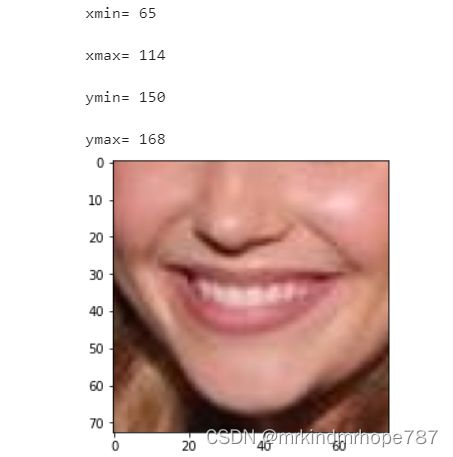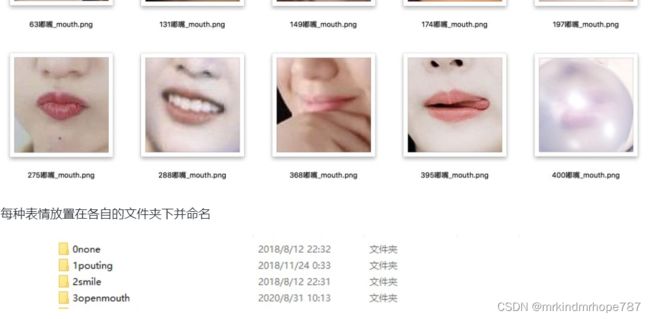基于人脸的常见表情识别实战--数据集制作
深度学习数据集的三大来源
- 公开数据集
- 业务人员采集
- 自己用爬虫搜集
爬虫数据的整理,统一图片后缀和重命名。方便后续读取,同时找出不能正常读取的图片。
使用的爬虫项目是:https://github.com/sczhengyabin/Image-Downloader ,可以按要求爬取百度、Bing、Google 上的图片,提供了非常人性化的 GUI 方便操作。
import os
import sys
import cv2
import numpy as np
def listfiles(rootDir):
list_dirs = os.walk(rootDir)
for root, dirs, files in list_dirs: # 遍历文件夹下的图片
for d in dirs:
print((os.path.join(root, d)))
for f in files:
fileid = f.split('.')[0] # 获得图片的名字,不含后缀
filepath = os.path.join(root, f)
print(filepath)
try:
src = cv2.imread(filepath, 1) # 读取原始图片,数据会加载到内存中
print("src=", filepath, src.shape)
os.remove(filepath) # 移除原来的图片
cv2.imwrite(os.path.join(root, fileid + ".jpg"), src) # 保存经过格式转换的图片
except:
os.remove(filepath)
continue
path = "./Emotion_Recognition_File/img_type_test/" # 输入图片路径即可,可以在这个文件夹下放置各种后缀名的图片,代码会将所有图片统一成 jpg 格式
listfiles(path)
删除爬虫爬到的非人脸图片。因为是用关键词搜索的,所以必然很多非人脸。
可以肉眼观察,也可用opencv自带的人脸检测器
cascade_path = './Emotion_Recognition_File/face_detect_model/haarcascade_frontalface_default.xml'
cascade = cv2.CascadeClassifier(cascade_path)
rects = cascade.detectMultiScale(im, 1.3, 5) # 人脸检测函数
基于Harr特征的级联分类器训练和检测。detectMultiScale多个尺度下都检测到人脸才确信图像中有人脸。
# coding:utf8
import cv2
import dlib
import numpy as np
import sys
import os
import matplotlib.pyplot as plt
# 人脸检测的接口,这个是 OpenCV 中自带的
cascade_path = './Emotion_Recognition_File/face_detect_model/haarcascade_frontalface_default.xml'
cascade = cv2.CascadeClassifier(cascade_path)
img_path = "./Emotion_Recognition_File/face_det_img/" # 测试图片路径
images = os.listdir(img_path)
for image in images:
im = cv2.imread(os.path.join(img_path, image), 1) # 读取图片
rects = cascade.detectMultiScale(im, 1.3, 5) # 人脸检测函数
print("检测到人脸的数量", len(rects))
if len(rects) == 0: # len(rects) 是检测人脸的数量,如果没有检测到人脸的话,会显示出图片,适合本地调试使用,在服务器上可能不会显示
# cv2.namedWindow('Result', 0)
# cv2.imshow('Result', im)
# print("没有检测到人脸")
pass
plt.imshow(im[:, :, ::-1]) # 显示
plt.show()
# os.remove(os.path.join(img_path, image)) #
# k = cv2.waitKey(0)
# if k == ord('q'): # 在英文状态下,按下按键 q 会关闭显示窗口
# break
# print()
# cv2.destroyAllWindows()

只对嘴唇部分的表情进⾏识别,所以我们的目标就是获取人脸嘴唇区域的图像,然后进行分类。我们利⽤ Opencv+Dlib 算法提取嘴唇区域, Dlib 算法会得到⾯部的 68 个关键点,我们从中得到嘴唇区域,并适当扩⼤。
图片无法加载时显示的文字
下面的代码可以对图片进行人脸检测,检测到人脸后,会将嘴巴区域分割出来,形成数据集!
# coding:utf8
import cv2
import dlib
import numpy as np
import sys
import os
import matplotlib.pyplot as plt
# 配置 Dlib 关键点检测路径
# 文件可以从 http://dlib.net/files/ 下载
PREDICTOR_PATH = "./Emotion_Recognition_File/face_detect_model/shape_predictor_68_face_landmarks.dat"
predictor = dlib.shape_predictor(PREDICTOR_PATH)
# 配置人脸检测器路径
cascade_path = './Emotion_Recognition_File/face_detect_model/haarcascade_frontalface_default.xml'
cascade = cv2.CascadeClassifier(cascade_path)
# 调用 cascade.detectMultiScale 人脸检测器和 Dlib 的关键点检测算法 predictor 获得关键点结果
def get_landmarks(im):
rects = cascade.detectMultiScale(im, 1.3, 5) # 人脸检测
x, y, w, h = rects[0] # 获取人脸的四个属性值,左上角坐标 x,y 、高宽 w、h
# print(x, y, w, h)
rect = dlib.rectangle(int(x), int(y), int(x + w), int(y + h))
return np.matrix([[p.x, p.y] for p in predictor(im, rect).parts()])
def annotate_landmarks(im, landmarks):
im = im.copy()
for idx, point in enumerate(landmarks):
pos = (point[0, 0], point[0, 1])
cv2.putText(im,
str(idx),
pos,
fontFace=cv2.FONT_HERSHEY_SCRIPT_SIMPLEX,
fontScale=0.4,
color=(0, 0, 255))
cv2.circle(im, pos, 5, color=(0, 255, 255))
return im
def getlipfromimage(im, landmarks):
xmin = 10000
xmax = 0
ymin = 10000
ymax = 0
# 根据最外围的关键点获取包围嘴唇的最小矩形框
# 68 个关键点是从
# 左耳朵0 -下巴-右耳朵16-左眉毛(17-21)-右眉毛(22-26)-左眼睛(36-41)
# 右眼睛(42-47)-鼻子从上到下(27-30)-鼻孔(31-35)
# 嘴巴外轮廓(48-59)嘴巴内轮廓(60-67)
for i in range(48, 67):
x = landmarks[i, 0]
y = landmarks[i, 1]
if x < xmin:
xmin = x
if x > xmax:
xmax = x
if y < ymin:
ymin = y
if y > ymax:
ymax = y
print("xmin=", xmin)
print("xmax=", xmax)
print("ymin=", ymin)
print("ymax=", ymax)
roiwidth = xmax - xmin
roiheight = ymax - ymin
roi = im[ymin:ymax, xmin:xmax, 0:3]
if roiwidth > roiheight:
dstlen = 1.5 * roiwidth
else:
dstlen = 1.5 * roiheight
diff_xlen = dstlen - roiwidth
diff_ylen = dstlen - roiheight
newx = xmin
newy = ymin
imagerows, imagecols, channel = im.shape
if newx >= diff_xlen / 2 and newx + roiwidth + diff_xlen / 2 < imagecols:
newx = newx - diff_xlen / 2
elif newx < diff_xlen / 2:
newx = 0
else:
newx = imagecols - dstlen
if newy >= diff_ylen / 2 and newy + roiheight + diff_ylen / 2 < imagerows:
newy = newy - diff_ylen / 2
elif newy < diff_ylen / 2:
newy = 0
else:
newy = imagerows - dstlen
roi = im[int(newy):int(newy + dstlen), int(newx):int(newx + dstlen), 0:3]
return roi
def listfiles(rootDir):
list_dirs = os.walk(rootDir)
for root, dirs, files in list_dirs:
for d in dirs:
print(os.path.join(root, d))
for f in files:
fileid = f.split('.')[0]
filepath = os.path.join(root, f)
try:
im = cv2.imread(filepath, 1)
landmarks = get_landmarks(im)
roi = getlipfromimage(im, landmarks)
roipath = filepath.replace('.jpg', '_mouth.png')
# cv2.imwrite(roipath, roi)
plt.imshow(roi[:, :, ::-1])
plt.show()
except:
# print("error")
continue
listfiles("./Emotion_Recognition_File/mouth_det_img/")


